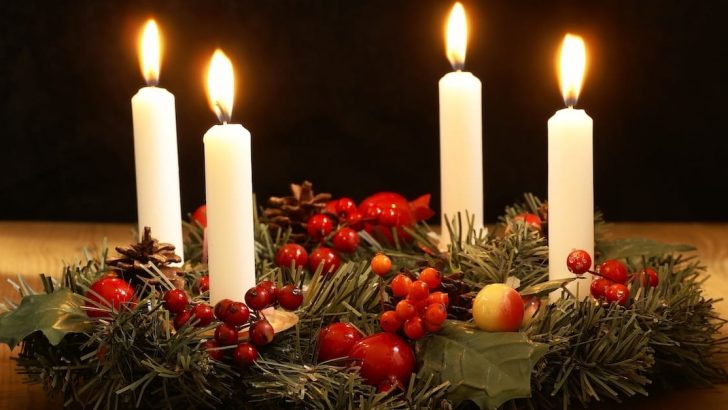The View
While at Mass on the first Sunday in Advent, I was momentarily struck by the beauty of the sanctuary, and the vestments worn by the priest and deacons. The chasuble, a heavy silk damask with a background of indigo, was exquisitely embroidered with clouds of gold and silver thread. All around, my eyes feasted on the majesty and beauty of the carvings and painting on the sanctuary walls, the golden vessels, the tabernacle door.
My gaze rose with the incense to the stained glass window above the high altar, and stopped at the depiction of the crucifixion. For a moment, I tried to imagine what that sacrifice on Calvary looked like: the cold, the pain, the cruelty, the indignity, the darkness of that moment. I looked back toward the altar, where once again, Calvary was being made present and thought how utterly different to that first Calvary Christ’s sacrifice is for the onlooker now, compared to then.
Those who watched in horror at what unfolded before their eyes did not yet know, perhaps could not conceive of Christ’s triumph over death. But we can, and for that reason, the sacrifice on Calvary as re-presented in each and every Mass, is glorious too.
It is right and fitting that the outward signs at Mass are glorious: all that depiction of beauty and majesty fit for a king, the excelling of human skills in building and making, painting and sculpting, all point towards a glory known, in the person of the risen Christ, and a hope of a glory yet to come. And there is no better time than Advent to contemplate this mystery.
Violence
If Christ’s death was appalling in its violence and suffering, His birth was far from salubrious. No crib for a bed, without the comfort of a home and familiar surroundings, the King of Kings was born in a stable and laid in a lowly manger. Yet we celebrate with feasting, and gifts, and decorations and lavish displays.
While the non-believer does this in a quasi-pagan fashion, without regard for or even interest in the reason behind the celebration, the Christian celebrates a glorious mystery: our freedom and salvation. Christ humbled himself by taking human form and coming into the world as a tiny infant, in order that in time he might pay the ransom for our sin and open the gates of heaven for us.
Hope then is an act of will: a humble surrender to God’s parental authority”
In recalling the anticipation of that first Christmas night during Advent, we look forward in like anticipation to Christ’s second coming. Advent is a season filled with hope and joyful expectation. We join with the Blessed Virgin Mary as she waits to bring forth the saviour of the world. We join with the prophets Isaiah and Micah, and all God’s people who looked forward to the coming of the Messiah.
For us though, we have tasted his glory, we have seen God’s promise to his people fulfilled in Christ’s first coming. We know that God keeps his promises, and so it is with joyful hope and expectation that we look forward to his second coming.
Advent then is the time of year when we might best meditate on the theological virtue of hope. Hope is not a feeling, as the world might have us believe. It is a positive act of the will. The theological virtue of hope responds to the aspiration to happiness which God has placed in the heart of every man, as the Catechism tells us.
Hope is something that comes to children easily. Hope requires that we place our trust in God’s promises to us – it is in this way that we become like little children who trust so completely.
Christ warned us explicitly: “Truly I say to you, unless you turn and become like children, you will never enter the kingdom of heaven.” This exhortation to become like little children was emphasised by Christ not only in his words but even more so in the manner of his incarnation: being conceived in his Mother’s womb, born as a tiny infant and growing through all the normal developmental stages of childhood.
The Christ-child, although God, completely placed his trust in his earthly parents to protect him and keep him safe. Though limited by their humanity and having nothing to compare with his omnipotence, the Word entrusted the care of his flesh to Mary and Joseph. In doing this, he showed us how we must be with his Father. Hope then is an act of will: a humble surrender to God’s parental authority, a child-like trust in his providence.
This Advent, I have resolved to try to recapture a child-like sense of wonder and awe at the Saviour’s birth. When a child is enraptured in that way, nothing can distract him from the wondrous thing he contemplates.
There are so many distractions in the run up to Christmas that it can be difficult to take the time to stop and wonder, yet that indeed is what is required: stopping.
Living Christmas all during Advent takes from the celebration of the joyful event of Christ’s birth. For many, Christmas is over after December 25 passes. Delaying putting up the Christmas decorations, and holding off on the Christmas songs can help us to really experience the season of Advent.
There are 12 days of Christmas, from December 25 to January 6, when we celebrate another glorious feast: the Epiphany.
Advent is the time to retreat and contemplate the mysteries we are about to experience”
The visit of the Magi showed that God’s promises to the chosen people were now open to all. Christ, though born into the Jewish people, came that all might be saved. That first Christmas foretold our own salvation. Advent then is the time to retreat and contemplate the mysteries we are about to experience and celebrate during the Christmas season.
Simply lighting a candle on a wreath in an ‘Advent-darkened room’ is enough to induce some wonder, or contemplating Christ’s lineage in a Jesse tree, or the miracle of Christmas night in the figurines of the crib.
A few minutes of quiet, even in a busy family home, help recall the mysteries we await, while the words of the Advent hymn describe our hope: O Come Emmanuel.


 Maria Steen
Maria Steen
